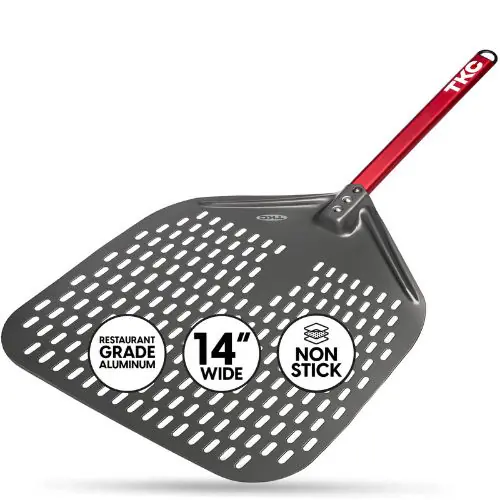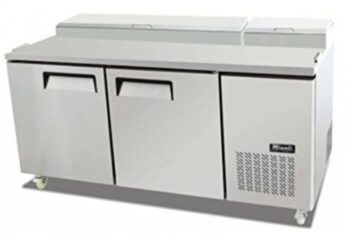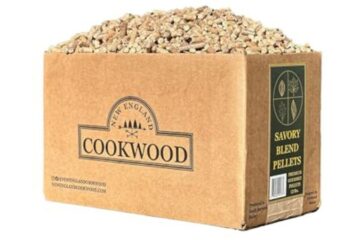Perforated Vs Non Perforated Pizza Peel: A perforated pizza peel is better because it removes excess flour, reduces food sticking, and helps slide the pizza off the peel more easily. Perforated peels are lighter and have smoother holes, allowing for easier lifting and dispatching of the pizza.
Choosing the right type of pizza peel is crucial for baking the perfect pizza, as it can significantly affect the outcome. One of the main debates in the pizza-making world is between perforated and non-perforated pizza peels. Both have their advantages and choosing the right one can greatly impact the outcome of your pizza.
We will explore the key differences between perforated and non-perforated pizza peels, and help you decide which one is best for your pizza-making needs. So, let’s dive in and discover the perks of each type of pizza peel.

Credit: www.amazon.com
Benefits Of A Perforated Pizza Peel
A perforated pizza peel offers numerous advantages compared to a non-perforated peel. It helps remove excess flour, reduces food sticking, and allows for easier sliding of pizza or food off the peel. Its perforations also promote a crispier crust and better heat distribution.
Using the right type of pizza peel is essential for baking delicious pizzas, as it can greatly influence the final product. One popular option is the perforated pizza peel, which offers several benefits that can enhance your pizza-making experience. From ease of lifting to less friction, a perforated pizza peel can help you achieve the perfect pizza crust every time.
Ease Of Lifting And Dispatching Your Pizza
One of the key advantages of using a perforated pizza peel is its ease of lifting and dispatching your pizza. The perforations in the peel allow for better airflow, minimizing the contact surface between the dough and the peel. This reduced contact surface means less friction, making it easier to slide your pizza onto the pizza stone or into the oven without any sticking or tearing.
Less Surface Means Less Friction
Unlike non-perforated pizza peels, which have a larger surface area, perforated peels have fewer contact points with the dough. This reduction in surface area means less friction between the dough and the peel, resulting in a smooth and seamless transfer. The reduced friction allows you to quickly and effortlessly move the pizza from the peel to the oven, ensuring a perfect bake every time.
Smooth And Rounded Holes For Smooth Dough Slide
One unique feature of a perforated pizza peel is the smooth and rounded holes along its surface. These holes are strategically designed to allow for a smooth dough slide. The smooth and rounded edges of the holes prevent any snagging or tearing of the dough, ensuring a seamless transfer from peel to oven. This feature is particularly beneficial when working with damp or sticky pizza dough, as it allows for easy and consistent movement.
In conclusion, a perforated pizza peel offers several benefits that can take your pizza-making skills to the next level. Its ease of lifting and dispatching, reduced friction, and smooth dough slide can help you achieve the perfect pizza crust with minimal effort. So, if you’re looking to improve your pizza-baking game, a perforated pizza peel is worth considering!

Credit: mama-cucina.com
Advantages Of A Non-perforated Pizza Peel
The advantages of a non-perforated pizza peel include less chance of food sticking and easier sliding off the peel. It also helps prevent excess flour from filling the oven with smoke.
Selecting the right pizza peel involves considering two primary options: perforated and non-perforated. While both have their own set of advantages, a non-perforated pizza peel offers several unique benefits that make it a popular choice among pizza enthusiasts. Let’s take a closer look at some of these advantages.
Sturdiness And Robustness
A non-perforated pizza peel is known for its sturdy construction and robustness. Unlike perforated peels which have holes in the surface, a non-perforated peel is solid and offers a more rigid foundation. This means that it can handle heavier and larger pizzas without the risk of bending or breaking. Its solid structure provides a reliable surface for lifting and transferring pizzas, ensuring that your culinary creations remain intact.
No Flour Falling Away
One of the drawbacks of using a perforated pizza peel is the possibility of flour falling away through the holes. This can lead to a messy cooking process and potentially fill your oven with smoke. With a non-perforated peel, you can say goodbye to these issues. Its solid surface prevents any excess flour from falling away, ensuring a cleaner cooking experience. This means no more smoke-filled ovens and a more enjoyable pizza-making process.
No Steam Escape
Another advantage of a non-perforated pizza peel is the absence of steam escape. When using a perforated peel, the steam generated during the baking process can escape through the holes. While this can help in achieving a crispier crust, it also means that some of the moisture and flavor are lost. With a non-perforated peel, the steam remains trapped, allowing it to circulate the pizza and enhancing the overall taste and texture.
Preventing Over-inflating And Huge Bubble
When pizza dough is heated, it tends to over-inflate and create a huge bubble. This can result in an unevenly cooked crust and an unappetizing appearance. However, a non-perforated pizza peel helps prevent this issue. By providing a solid and uniform surface, it ensures that the dough remains flat and evenly distributed, allowing for a perfectly cooked pizza every time.
In conclusion, a non-perforated pizza peel offers several advantages that make it a worthwhile investment for any pizza lover. Its sturdiness, lack of flour falling away, prevention of steam escape, and ability to prevent over-inflating and huge bubbles all contribute to a more enjoyable and consistent pizza-making experience. So, if you’re looking for a reliable and efficient pizza peel, consider opting for a non-perforated one.
Factors To Consider When Choosing A Pizza Peel
When choosing a pizza peel, there are factors to consider, such as whether to go for a perforated or non-perforated peel. A perforated peel helps remove excess flour and reduces contact surface with food, preventing sticking and making it easier to slide the pizza off the peel.
On the other hand, non-perforated peels are more rigid and robust.
Choosing a pizza peel requires careful consideration of a few important factors. In this section, we will discuss three key factors that can help you make the right decision: functionality and ease of use, durability and materials, and personal preference.
Functionality And Ease Of Use
The functionality and ease of use of a pizza peel are crucial aspects to consider. A pizza peel with the right design and features can greatly enhance your pizza-making experience. Here are some points to keep in mind:
- Surface Area: A perforated pizza peel has less contact surface with your food, reducing the chance of the dough sticking. It also helps slide the pizza or food off the peel easier.
- Friction: Perforated peels have smooth and rounded holes at the ends, allowing even the dampest dough to slide smoothly without sticking.
- Lifting and Dispatching: Perforated pizza peels make it easier to lift and dispatch your pizza, thanks to their lighter weight.
Durability And Materials
Another important factor when choosing a pizza peel is durability and the materials used. Here are some points to consider:
- Rigidity and Robustness: Non-perforated peels are often more rigid and robust, making them a durable choice in the long run.
- Weight: Perforated peels are lighter due to the reduced material used in their construction.
Personal Preference
Lastly, personal preference plays a significant role in choosing the right pizza peel. Factors such as style, design, and preference for perforated or non-perforated options can vary from person to person. Consider your preferences and requirements before making a decision.
In conclusion, when choosing a pizza peel, you need to consider the functionality and ease of use, durability, and materials, and your personal preferences. Finding the perfect pizza peel for your needs will ultimately enhance your pizza-making experience and help you achieve the perfect pizza crust every time.

Credit: www.amazon.com
Opinions Of Experts And Customers
Deciding between a perforated and non-perforated pizza peel can be challenging when trying to find the option that best suits your needs. However, hearing the perspectives of experts and customers who have hands-on experience with both types of pizza peels can provide valuable insight.
Perspectives From Pizza Makers And Chefs
Pizza makers and chefs have varying opinions when it comes to the use of perforated and non-perforated pizza peels. Some argue that perforated peels have distinct advantages, including the ability to remove excess flour, resulting in a cleaner cooking process. With fewer contact surfaces, there is also less chance of the pizza sticking to the peel, making it easier to slide the pizza off onto the stone or oven rack for cooking.
On the other hand, proponents of non-perforated peels highlight their sturdiness and rigidity, making them suitable for heavier or larger pizzas. These peels are also versatile, allowing for the transfer of other baked goods like bread and pastries without any compromises.
Reviews And Testimonials From Customers
Customer reviews offer real insights into the practicality and performance of perforated and non-perforated pizza peels. Many customers who have opted for perforated peels appreciate the ease of use and how the perforations allow the flour to fall away, preventing any undesirable burning or bitterness. They find that pizzas slide off effortlessly and enjoy the added crispiness of the crust achieved through the escape of steam.
Conversely, customers who have chosen non-perforated peels appreciate their sturdy construction and durability. They find these peels to be reliable tools for transferring pizzas of various sizes and weights into the oven without any concerns about bending or warping.
Experiences Shared On Forums And Reddit
Forums and Reddit threads are valuable platforms for people to share their personal experiences and seek advice from fellow pizza enthusiasts. Here, individuals often discuss the pros and cons of both perforated and non-perforated pizza peels based on their firsthand encounters.
On these platforms, users express satisfaction with perforated peels for their ability to remove excess flour, preventing smoke and improving the overall taste of the pizza. Others mention the ease of sliding the pizza off the peel, particularly when working with wet or delicate dough.
Meanwhile, users champion the use of non-perforated peels for their robust construction and versatility in handling pizzas of various sizes. Some mention that these peels provide a stable platform, ensuring pizzas maintain their shape during transfer and cooking.
Ultimately, the opinions of experts and customers differ based on personal preferences and specific use cases. Both perforated and non-perforated pizza peels have their unique advantages and benefits, and it is essential to consider these perspectives when making your decision.
Further Reading And Resources
For those who want to dive deeper into the world of pizza peels, we have curated a list of valuable resources and information to help you make an informed decision. Whether you are a beginner or a seasoned pizza-making enthusiast, these resources will provide you with the knowledge and tips you need to enhance your pizza-making skills.
Pizza Peel Buyer’s Guide
If you are in the market for a new pizza peel or looking to upgrade your current one, our comprehensive buyer’s guide will walk you through the factors to consider before making a purchase. From the material and size of the peel to the handle design and maintenance tips, we cover everything you need to know to choose the perfect pizza peel for your needs.
Comparison Of Different Pizza Peels
Not all pizza peels are created equal, and understanding the differences between perforated and non-perforated pizza peels is crucial. Our detailed comparison guide lays out the pros and cons of each type, helping you decide which one is better suited for your pizza-making style. We also explore the various benefits of using a perforated pizza peel, such as reducing flour smoke and ensuring easy food removal.
Recipes And Tips For Better Pizza Making
Take your pizza-making skills to the next level with our collection of delicious recipes and expert tips. We share secrets from renowned pizza chefs to help you achieve a crispy crust, mouthwatering toppings, and perfect dough consistency. Whether you prefer classic Margherita or adventurous toppings, these recipes will inspire you to create gourmet pizzas in the comfort of your kitchen.
With these valuable resources at your disposal, you’ll soon become a pizza-making pro. From choosing the right pizza peel to mastering the art of dough preparation, your homemade pizzas will rival those from your favorite pizzeria. Happy cooking!
Frequently Asked Questions For Perforated Vs Non Perforated Pizza Peel
Is It Better To Have A Perforated Pizza Peel?
A perforated pizza peel helps to remove excess flour, reducing the chance of food sticking and making it easier to slide the pizza or food off the peel. Perforated peels also allow steam to escape for a crispier crust. They are lighter and offer ease of lifting and dispatching the pizza.
What Is The Difference Between Flat And Perforated Pizza Peels?
The main difference between flat and perforated pizza peels is that perforated peels have holes, which helps to remove excess flour and prevent food from sticking. Perforated peels are lighter and easier to lift and slide the pizza off. On the other hand, flat peels are more rigid and robust.
Can You Make A Pizza On A Perforated Peel?
Yes, you can make a pizza on a perforated peel. It helps remove excess flour, prevents sticking, and allows for easier transfer of the pizza.
Why Do You Perforate Pizza Dough?
Perforating pizza dough helps prevent it from over-inflating and creating a huge bubble when heated. It also allows heat and toppings to settle evenly on the surface of the dough. Additionally, perforations on a pizza peel help remove excess flour and make it easier to slide the pizza off the peel.
Conclusion
Having a perforated pizza peel can make a significant difference in your pizza-making experience. The perforated design helps to remove excess flour, reducing the chances of your food sticking and making it easier to slide the pizza or food off the peel.
Additionally, the perforations allow steam to escape, resulting in a crispier and tastier crust. So, whether you are a professional chef or a home cook, investing in a perforated pizza peel can enhance your cooking skills and elevate your pizzas to the next level.

As the author of the “Ultimate Pizza Guide: Recipes, Tips & Secrets Revealed,” I’m dedicated to sharing my love for pizza and empowering others to create delicious homemade pizzas with ease. Join me on a journey to uncover the secrets to perfecting your pizza game!


